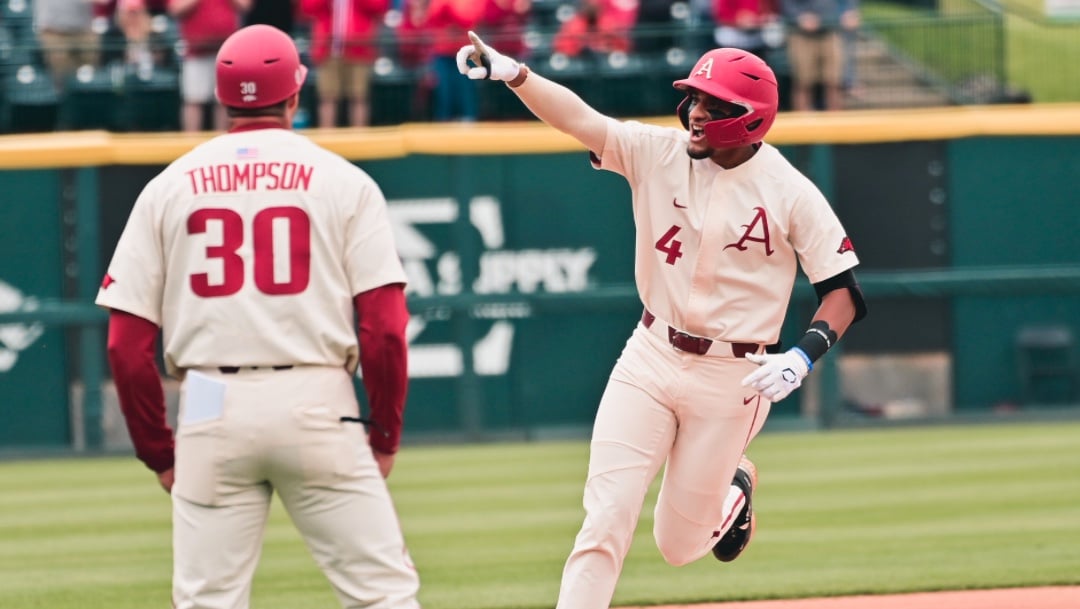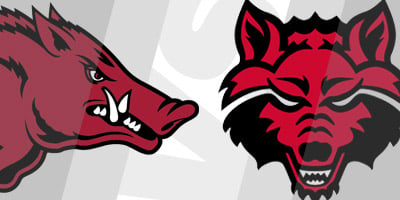
Photo: ArkansasRazorbacks.com
Wow, what a huge night and a huge opportunity for the Arkansas State Red Wolves at 6:30 p.m. at Baum-Walker Stadium when they face the Arkansas Razorbacks.
Tonight might very well be the biggest baseball game in the program’s history.
Not only do the Red Wolves get their first opportunity ever to take a bite out of the haunch of the dreaded Razorbacks, but they get to do it while the Hogs are reigning as the unanimous No. 1 team in the land.

Next up for the No. 1 Razorbacks
Opponent: vs. Arkansas State
When: 6:30 p.m. Tuesday, May 11
Where: Fayetteville
Television: SEC Network+
Upcoming games
May 14 – at Tennessee, SEC Network+
May 15 – at Tennessee, SEC Network
May 16 – at Tennessee, SEC Network+
Growing up in eastern Arkansas, I’ve heard ASU fans gripe and moan about the Hogs running from first the Indians and later the Red Wolves ever since the 1970s.
I remember the T-shirts that had ASU mascot “Injun’ Joe” with a tomahawk raised high chasing a Razorback across the front with “Keep running Hogs” printed on the back at what was perhaps the height of the rivalry-that-wasn’t in the mid-1970s.
I’m guessing it was inspired by ASU’s undefeated Division I football squad in 1975, which remains one of only four DI teams to go undefeated and not win a national title.
The Hogs were 10-2 that season and Southwest Conference tri-champions with Texas and Texas A&M. The Razorbacks capped the season by wearing out Georgia, 31-10, in the Cotton Bowl and finishing No. 7. ASU was unranked and jealous.
ASU, of course, wanted a piece of the Hogs or thought they did, but Arkansas athletic director Frank Broyles believed in the policy instituted by the man who hired him, John Barnhill ,that it was in the best interests of the Razorback program not to elevate Arkansas State’s program by playing the Indians.
The Hogs needed Razorbackers from all corners of the state and everywhere in between to support the Hogs for them to remain competitive in the SWC. Playing ASU would divide loyalties.
You have to remember the economy of the state was quite different when Barnhill instituted the policy in the 1940s. The money in the state then was actually spread across the farming communities of eastern and southern Arkansas as well as in the Little Rock metropolitan area.
Northwest Arkansas did not begin to transform into the economic powerhouse that we know today until the 1980s. Hard times hit farmers in the 1970s with staggering inflation that pushed all but the big corporate growers slowly out of business. Ever since the state’s economic power source has shifted north and west.
Towns in eastern and southern Arkansas are a shell of what they were when the Razorbacks began to grow in prominence under Broyles as the Hogs’ head football coach. The Razorbacks all-sports program did not begin to flourish until Broyles took over as athletic director in the mid1970s and a trio of fantastic coaches — Norm DeBriyn, Eddie Sutton, and the truly great John McDonnell — made Razorback baseball, basketball and track and field nationally competitive in the 1970s and ‘80s.
Now, I’d be foolish to say that Broyles, his coaches, and scores of Razorback athletes accomplished that success based on the policy of not playing ASU. That’s just not true.
However, what did propel Arkansas into a successful all-sports program was Barnhill and Broyles consolidating statewide support for the Razorbacks. That plan was a many-pronged approach that did include not dividing loyalties within the state.
Why elevate ASU’s program and take the chance of dividing your fanbase and recruiting territory in such a small and economically challenged state?
With Arkansas and ASU not competing against each other, fans weren’t forced to pick between one or the other. More importantly for the Razorbacks, most donors focused primarily on the Hogs, while some opted to support both. And they could do that without being pulled both ways.
However, times have changed, and Razorback coaches and most importantly athletic director Hunter Yurachek now see advantages to playing ASU that outweigh the advantages of not playing the Red Wolves.
Practically every other state program in the nation competes against the other programs in their state on a regular basis. So why not the Razorbacks?
Tonight’s historic baseball game is a result of that line of thinking. To Razorback coach Dave Van Horn and his staff, this is just another midweek game. I have a feeling the Razorback players probably feel the same way. The majority of the Hogs aren’t in-state products, and even if they were, I don’t think they see ASU as rivals. The Hogs have been highly ranked all year. They generally get every opponent’s best shot.
I doubt that is the feeling in the Red Wolves locker room, though. This isn’t just another non-conference game for Tommy Raffo’s squad or to ASU fans. It’s a shot at the Hogs, and it’s a shot at toppling the No. 1 team in the nation. It’s a huge opportunity.
That said ASU (16-24) is used to playing SEC opponents. The Red Wolves lost a couple of games to No. 18 Ole Miss this season with one being pretty tight. They also lost to No. 3 Mississippi State. ASU took a game from Oklahoma in a three-game series against the Sooners. If you remember, Oklahoma whipped the Hogs 8-5 in the middle of a three-game Razorback losing streak in mid-March.
Tonight’s game isn’t a gimme for the Hogs (36-9). If they don’t play well or are looking forward to this weekend’s series at No. 4 Tennessee, the Red Wolves could shock them.
If that happens, that would really stoke the flames of this burgeoning rivalry.

